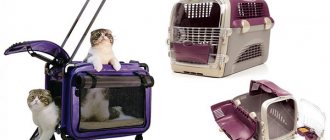Any animal does not like to travel, and transportation for cats is a serious stress for it. Even a short trip in a car, and even more so a long trip by plane or train.
Cats become attached to one habitat; changing homes leads to a decline in mood and even health problems. It is worth ensuring comfortable conditions during the trip. There are also rules and regulations regarding how to transport a cat on an airplane and other public transport that owners should consider.
How to prepare documents for transportation
The rules for transporting cats state that the airline must be warned in advance that the passenger is flying with his pet. This must be done at least 36 hours before the flight. You must have certain documents with you, without which the animal cannot be brought on board the plane.
Documents for transporting a cat in Russia
The rules for transporting cats on an airplane in Russia set standards that are a little more loyal and simpler than transportation on international routes. For domestic flights you need to have:
- Veterinary passport. It is issued by a veterinary clinic, it indicates all the mandatory vaccinations that the animal must have.
- State certificate No. 1. It can be obtained from the State Veterinary Station.
- Certificate of completed microchipping.
Documents must be completed in advance. An animal that does not have mandatory vaccinations, according to current legislation, cannot be allowed on board the aircraft.
Documents for taking a cat abroad
If you are planning an international flight, the documents must be as follows:
- international veterinary passport;
- certificate of the value of the animal (exporting animals from the Red Book and those with a special status is prohibited by law);
- certificate of breeding value;
- veterinary certificate No. 1;
- the animal must be microchipped;
The latest certificate must be exchanged at the check-in counter at the airport and instead obtained from an airline employee an international veterinary certificate, which is accepted by all countries of the world, wherever the passenger flies. This document must be kept and presented at the airport of arrival. If there is a return flight, this document will also be required.
Interesting read: everything about Turkish Angora cats.
What vaccinations will be needed?
Transporting a cat on an airplane requires vaccination. The pet must have had a rabies vaccination within the last year, but no less than 20 days before the flight. According to EU requirements, this period is 21 days. It is worth using a drug that does not contradict veterinary standards in the country of arrival. A veterinarian will help you choose one.
It is also necessary to have marks about panleukopenia. A special sticker with the date, drug, signature and stamp of the doctor is placed in the passport. The animal must undergo anthelmintic treatment.
Question to the expert
Do all countries have the same standards for transporting cats?
Depending on the country, there are other requirements. Before purchasing a ticket, you must find out all the current requirements and pass them. It is better to do this in advance, preferably a month before the upcoming flight.
After moving
The worst is over! Now your goal is to help your cat settle into his new home as easily as possible.
Follow your cat.
The more stressed your cat is, the more gradual you'll want to introduce him to a new space. It may be too difficult for a stressed cat to be free to run the house right away, especially since she will need to learn a new litter box location in an unfamiliar environment. First, choose a house for your cat and store her things there, including her litter box. Also spend a lot of time in the room interacting with the cat and doing other normal activities. As your cat calms down, curiosity will replace fear and she will be ready to expand her exploration.
Deep cleaning.
This is especially important if there were other animals in the house before you moved in. Cats have a strong sense of smell, and they can pick up not only the general odors of animals, but also any stress that those animals have been under, which can increase their own. Shampoo and deep clean carpets, vacuum every square inch to remove any remaining fur and wipe with a cloth
Show your cat that she has nothing to be afraid of, and gradually she should begin to come to her senses and adapt to her new environment.
Rules for transporting cats on an airplane: in the cabin and luggage
To make the flight comfortable and safe, you need to start preparing the animal a few days before the trip. It is advisable to introduce the cat to his carrier container, where he will spend several hours.
Sedatives should not be given. When a plane takes off and lands, a pressure drop occurs that affects the animal's cardiovascular system. Substances that are in the blood can only aggravate this, even to the death of the animal.
Many owners place the pet's favorite items, such as his toys, inside the carrier. The cat, feeling the smells familiar to it, is less nervous.
What is important to know when booking
Before booking, you need to check with the airline itself about the rules for transporting cats on the plane. This can be done via a hotline, at a ticket sales point, or on the carrier’s official website or ticket sales aggregators. You need to know a number of formalities:
- are there any restrictions on the transportation of animals;
- what conditions will the cat be in during the flight?
- what are the carrying requirements?
- how much does this service cost?
It is worth finding out how many animals can be on the plane at the same time. Some companies limit their number. The owner must obtain permission from the carrier to transport his pet. If the animal is transported in the luggage compartment, permission is obtained after purchasing the ticket, if in the cabin of the aircraft - before the ticket is purchased.
Useful material: choosing a scratching post for a cat.
If you plan to fly internationally, you need to find out the transportation rules in force in another country. Sometimes quarantine is imposed on the import of any animals. Such measures are used in special cases and are quite rare, but to avoid unpleasant situations at the airport, it is better to discuss this in advance.
Having learned all the nuances, it is required to notify the airline at least 36 hours before departure that the passenger will have his pet with him.
How to take a cat on board an airplane
Some carriers allow this, others, on the contrary, prohibit this. You need to find out these subtleties in advance, when booking a ticket, with the company itself. According to current regulations, only an adult and legally capable passenger can transport an animal in the cabin.
It is imperative that the cat is in a carrier, which must also meet certain requirements. The animal must weigh no more than 8 kg, which automatically deprives large breeds, such as Maine Coons, of this opportunity.
Cost of transporting a cat on an airplane
Transporting cats on an airplane is in most cases free of charge. Many owners want to take them to the salon. In this case, you need to pay for a boarding pass and register the cat as “special cargo.”
The average cost of transportation is about 4,000 on domestic flights and approximately 5,000 rubles on international flights. In this case, the airline must receive advance warning from the animal owner.
Typically, such passengers will receive more comfortable seats on board if they are not occupied by passengers with children or people with special needs.
Is it possible to transport a cat unaccompanied?
This option is provided by most airlines. In this case, the cat moves in a special compartment with an optimal climate without being accompanied by its owner. To use this service you will need to provide a number of documents:
- copy of the owner's passport;
- veterinary passport of the animal;
- veterinary certificate;
The cost of the flight is paid twice; to calculate the exact amount, the weight of the carrier along with the animal, as well as its dimensions, are taken into account.
Receiving cats after a flight
After arriving at your destination, you can pick up your pet at a special place, which is located near the baggage claim point. You can find out the specific location at the check-in counter or an airport employee.
Usually animals are given out after luggage. They are transported on special carts. If there is a transfer to another plane, the animal will be transported by the airline services to the new flight.
During the move
When moving day arrives, your first priority will be to ensure your cat's safety and security. There are still some things you can do to manage the stress at this stage, but you also just need to accept that this day will probably be a little anxious for your feline companion. Luckily, with a little consideration and kindness, you can help make things a little easier for them.
Feed a small amount of food.
Stress and anxiety are felt throughout the body, and the stomach is no exception. Help reduce your cat's chance of stomach upset or vomiting by slightly reducing his food intake that day.
Keep your cat under control.
You'll be opening and closing your front door frequently when it comes time to load a moving truck, and the last thing you want to risk is your cat running away. Be careful to keep your cat within sight at all times, especially if you are using movers and there are strangers around. You don't have to put your cat in the carrier until it is necessary, but you should keep it in one safe place.
Before you start loading the truck, clear out one room completely—it could just be the bathroom—and put your cat there with food, water, and toys, as well as her bed and litter box. If friends or movers come to help you move, be sure to post a sign on the door indicating that the cat is inside and the door must remain closed. Although your cat may not like being locked up, you will at least have peace of mind knowing that she is safe and that she will feel comfortable in her familiar things and smells.
Transportation time.
Load your cat into the carrier right before you head out. While you're on the road, resist the urge to let them out, even if they're clearly unhappy. Stay as calm as possible, as animals are good at reading our body language - the calmer you are, the calmer your cat should be. Only open the carrier to let your cat out when you are in your new home and in a room with the door closed. Then repeat what you did at your old place, keeping the cat in the room until all the boxes are inside and the front door is tightly closed. Be sure to put the same familiar things in the new room (some food, water, toys, a bed, and a litter box) so that the surroundings smell nice. Scatter treats around the room to encourage them to explore while they're there.
What you need to transport a cat by train
Transporting a cat on a train is not the easiest test for its owners. It is unknown how the animal will behave during the trip, and the process may be complicated by the requirements of the railway company. To avoid unpleasant situations, there are a number of solutions that will help make this comfortable for both humans and cats.
Interesting article: all about the Abyssinian cat breed.
Which car is suitable: passenger or baggage
The only passenger carrier in our country is Russian Railways. If such a move is planned, it is better to find out in advance the existing rules of this state company in the field of transporting animals.
If you are using a shared carriage where the passenger is seated, you will need to pay extra for the cat and present a transportation ticket (receipt). There are other types of wagons that have different requirements.
Some trains provide only 1-2 seat compartments for transporting animals. This is a question worth asking when purchasing a ticket. Most often, you can only travel with an animal in a compartment carriage. This is dictated so as not to create inconvenience to other passengers. The main conditions for transporting animals by Russian Railways trains are listed in the table below:
Table of conditions for transporting animals in Russian Railways cars.
Cost of transporting cats on a train
Transporting a cat on a train has its own cost, which depends on the route, carriage, type of train and other factors. An additional fee is charged in reserved seat, seated and shared carriages. If the passenger travels in a compartment, no additional payment is required. The pet carrier is located in the place purchased by the owner.
If we are talking about high-speed trains, you will also have to pay extra. The “swallow” charges a fixed fee of 150 rubles. In Sapsan it is already included in the ticket price.
Transportation on long-distance trains
When transporting an animal, the owner must ensure sanitary and hygienic requirements, as well as the safety of other passengers.
Long-distance travel is considered to be a route longer than 700 km. The cost of transporting a cat will depend on the distance, for example, for a distance of more than 12,000 km the cost will be 3,000 rubles. To ensure your pet’s comfort, you must fulfill a number of requirements:
- ensure constant access to water;
- carry anti-motion sickness pills;
- If possible, at stations with a large parking lot, take the container with the animal into the fresh air and give her the opportunity to go to the toilet.
Also, when moving long distances, it is worth considering the cat’s diet. It is optimal to choose dry ready-made food. You should not feed your pet too often.
Transporting cats unaccompanied
The Russian Railways company offers transportation of pets without human accompaniment. This happens in the luggage compartment. The owner must write a corresponding statement at the box office and comply with a number of requirements:
- cage or special carrier;
- veterinary documents;
- food, water, hygiene products for the cat.
The cost of such a service is determined by the distance. During the entire journey, the animal will be under the supervision of train staff.
Delivery services in Russia by car
Like any service, animal transfer depends on the offer of its provider and demand.
When transporting animals, the following are also taken into account:
- transportation features;
- type of animal, its size;
- travel distance;
- need for support;
- need for anticipation;
- direction of travel: one way or with delivery to the point of departure.
In the table we give the approximate cost of transferring animals (cats, dogs) using the example of one of the car rental companies for transporting animals in Moscow that provide this service. In other regions and companies, the price per km may vary.
Table 1. Cost of transporting animals in the Moscow region in 2022.
| Territory or service | Duration of the trip | price, rub. |
| Moscow and MKAD | 2 hours | 2 500 |
| from 2 hours | 2,500 + 600 per hour | |
| beyond the Moscow Ring Road | more than 2 hours about 100 km | 2,500 + 30 for each km |
| expectation | from 15 min | 600 per hour |
| from home and back | — | 5,000 (total) |
| trip at night | 23.00 – 7.00 | 3,500 (total) |
Transporting a cat in a car
There are some tips from experienced travelers on how to transport a cat in a car over long distances. It is better to use a container made of durable, thick plastic. It is advisable that it be equipped with a net so that the animal does not have the opportunity to run out of it. Another advantage is the constant supply of fresh air.
The carrier must be secured to the back seat with straps. This is necessary for the safety of passengers and the animal. In the event of an accident, an unsecured carrier can cause additional injury to people and the cat.
During the trip, the animal must receive water and food. If you plan to travel abroad in your car, you must have the same documents with you as for transporting a cat by plane. Otherwise, the customs authorities of another state have the right not to allow the pet into their territory.
Types of restraint and rules for safe travel
Pets need to be accustomed to everything from birth. Proper placement in the car is no exception. The sooner you instill in your animal the rules of behavior in a vehicle, the fewer problems will arise in the future; Do not allow pets to be free in the car, even when driving short distances. An accident can happen at any time; The best place to transport animals is in the trunk of a hatchback, station wagon or SUV; To prevent your pet from climbing into the cabin, you need to make a special fencing for the luggage space. It can be in the form of a lattice or mesh. The main condition is the reliability and strength of such a design. Some new cars are equipped with a similar structure from the factory; Large dogs are equipped with a living space in the luggage compartment, fastened with special seat belts or placed in special hammocks; Smaller animals are recommended to be transported in containers. Carrying bags come in different sizes, and you need to select them based on the size of your pet. There must be enough free space inside for movement and ventilation holes for air circulation; If the trunk is occupied, then the container with the pet is placed on the floor and secured motionless with the back of the seat. Placing a carrier on a car sofa is extremely dangerous for both the animal and you - with sudden braking, it will turn into a cannon shell with enormous destructive power. Although some containers are equipped with fastenings for seat belts, you should not trust such fastening. The plastic of the bag may not withstand the pressure at the moment of collision, cracking and injuring the pet; Special harnesses with seat belts can also protect against damage. They look like vests that tightly encircle the animal's body, and are fastened to ordinary car belts or into a clasp
It is important that they are made of durable material, do not cause discomfort to the animal, and that the carabiners of the fastenings can withstand heavy loads; To keep the seats clean and safe, place a special rug or cover under your pet; If the animal is afraid of traveling and does not tolerate the road well, give it sedative drops before leaving.
Possible problems and advice from experienced travelers
When planning your trip, you should think about the trip in advance, especially if it will take place with your beloved pet. Forethought will help people and cats endure the road comfortably. The main requirement of any trip is to ensure the safety of all participants - the animal itself, the owner, and other passengers.
Microchip implantation
To move a cat across the country, microchipping is not a requirement. This procedure must be done before rabies vaccination. This is regulated by current EU regulations. The chip itself looks like a small grain, the size of a grain of rice. It is implanted under the skin on the animal’s withers so as not to create discomfort.
A barcode is entered into the veterinary passport, which is also entered into the electronic database. It first appeared in the European Union, then moved to the USA and Canada. In these countries this procedure is mandatory. Owners who fail to do this face a heavy fine.
The main idea of chipping is to make it easier to find “lost items” so that if found, they can be returned to the owner. Also, all information about a given belly is recorded on the chip, including its vaccinations, diseases and other data.
If during the trip the cat opens its mouth and breathes rapidly during transportation, this indicates that it is motion sick. In this case, you can give medications for motion sickness, if possible, provide a flow of clean air, and give water. It is not advisable to feed a cat in this condition.
What does a cat need on the road?
In order for your pet to survive a long trip, you need to have some items with you. Be sure to stock up on the following:
- carrying;
- tray;
- harness;
- water;
- dry food;
- napkins;
- disposable waterproof diapers;
- soft bedding;
- Trash bags;
- sedatives;
- disinfectant against unpleasant odors.
All of these items will be useful, especially during a long trip.
Is a container required for transportation?
A bag for transporting cats is a must, regardless of the chosen transport. It is not recommended to take out an animal while traveling, since in a state of fear it can simply run away, bite, scratch and escape from your hands.
The container must be made of plastic, have a solid bottom, and a mesh. These are the basic requirements that most airlines require for this cat accessory. Although a soft backpack for transporting cats is more convenient for the owner of the animal, it is unlikely to be suitable for a flight.
The nuances of transporting kittens
Many carriers do not accept kittens under four months of age for transportation. This is due to the fact that such kittens, due to their age, cannot receive some mandatory vaccinations. Many of them are placed only at three months, but must undergo quarantine. It is better to transport kittens with their mother. One or more kittens are not allowed.
Sedatives for cats
Using sedatives will reduce your cat's stress. It is advisable to coordinate the choice of a specific drug with your veterinarian. If you plan to travel by plane, sedatives for cats during transportation can be dangerous.
An overdose of the drug can also only cause problems, and sometimes even cause death.
How to prepare a cat for flight
For several days, the cat’s food should be limited, but not completely. Access to water must remain unrestricted. It is worth preparing a carrier, toys and other necessary items in advance.
Useful tips
Additionally, I would like to share tips based on my personal experience and recommendations from experts.
Feeding
Eating a large breakfast before a trip can lead to nausea, vomiting and diarrhea from stress. Offer your cat some food and water. If the trip takes a long time, take food with you and, regardless of the duration of transportation, water.
It is advisable to take homemade bowls so that the pet will be attracted to the native smell. But when this is not possible, I take folding dishes. It is very comfortable!
Not eating on the road is normal, don’t panic. Offer your cat water regularly.
Comfort
Prepare your pet for the trip as far in advance as possible. When traveling by car, let the cat sniff the interior, start the engine so that the pet gets used to new sounds.
Cats shed their fur when stressed, so don't be surprised if you see a coat of fur in the salon. Buy a special cover for the interior or get ready to wash the covers.
Domestic cats have a hard time traveling on public transport because the smells and sounds are completely unfamiliar to them. I know that many owners periodically take their cat outside in their arms before a planned trip to give them the opportunity to get used to the environment.
Make regular stops if the trip takes more than 3 hours.
Safety
It is best to transport a cat in a car on the floor behind the driver's seat. Carrying by hand is a bad idea. The animal may become frightened and suddenly try to get out of the car, including through the driver's seat. This may lead to an accident. In addition, if the cat goes to the toilet, the feces will remain on the rubber mat, which is easy to clean afterwards, which cannot be said about the salon.
Pets are never transported in the trunk!
Avoid drafts and excessive heat. If you see that the cat is hot, stop and give him water. Turn on the air conditioner.
In transport there is a draft on the floor, so if possible, keep the carrier on your lap. I recommend purchasing a cooling mat for transportation.
Fines
According to clause 2.2.5 of veterinary and sanitary rules No. 432-5 of January 30, 1986, approved by the USSR State Agricultural Industry, responsibility for the transportation of animals lies with the shipper.
Art. 10.8 Code of Administrative Offenses of the Russian Federation No. 195 of December 30, 2001, as amended. dated April 3, 2018, administrative liability is imposed on individuals, legal entities and officials. The fine varies depending on the violation.
Table 2. Fines for transporting animals in a car or violating veterinary and sanitary rules in Russia.
| Violation | Person punished | price, rub. |
| Non-compliance of transportation with veterinary and sanitary rules | individual | 500 – 1 000 |
| official | 3 000 – 5 000 | |
| legal | 10 000 – 20 000 | |
| Lack of documents, except for personal use and farm animals | individual | 3 000 – 5 000 |
| official | 30 000 – 40 000 | |
| legal | 300 000 – 500 000 |
Pet owners should think about possible trips before adopting a four-legged friend. If the trips are frequent and tiring, this will not be beneficial.
In this case, you should teach from a young age to create the most comfortable conditions possible.
The greatest attention is paid to international relocations, because it is not only a long journey, but also the collection of additional documents, vaccinations, diagnostics, and prevention
The nuances of transferring an animal to alternative feeds
In most cases, dietary changes do not go completely smoothly. An animal accustomed to a certain feeding gets used to constant nutrition and finds it quite difficult to refuse it. In this case, even if you know how to properly switch a cat to another food, this does not mean that your pet will be delighted with the changes and immediately switch to a new food, giving up his favorite treats.
The main thing that a cat owner will need in order to make the transition to a new food is patience. The innate cunning of cats allows them to quite successfully manipulate their owners, clearly showing their negative attitude towards the new food. Some animals strive to “bury” the new food offered to them, thus comparing it with litter for their toilet. Other animals, not paying attention to the food in the bowl, make a suffering face or meow painfully, demonstrating their hunger.











